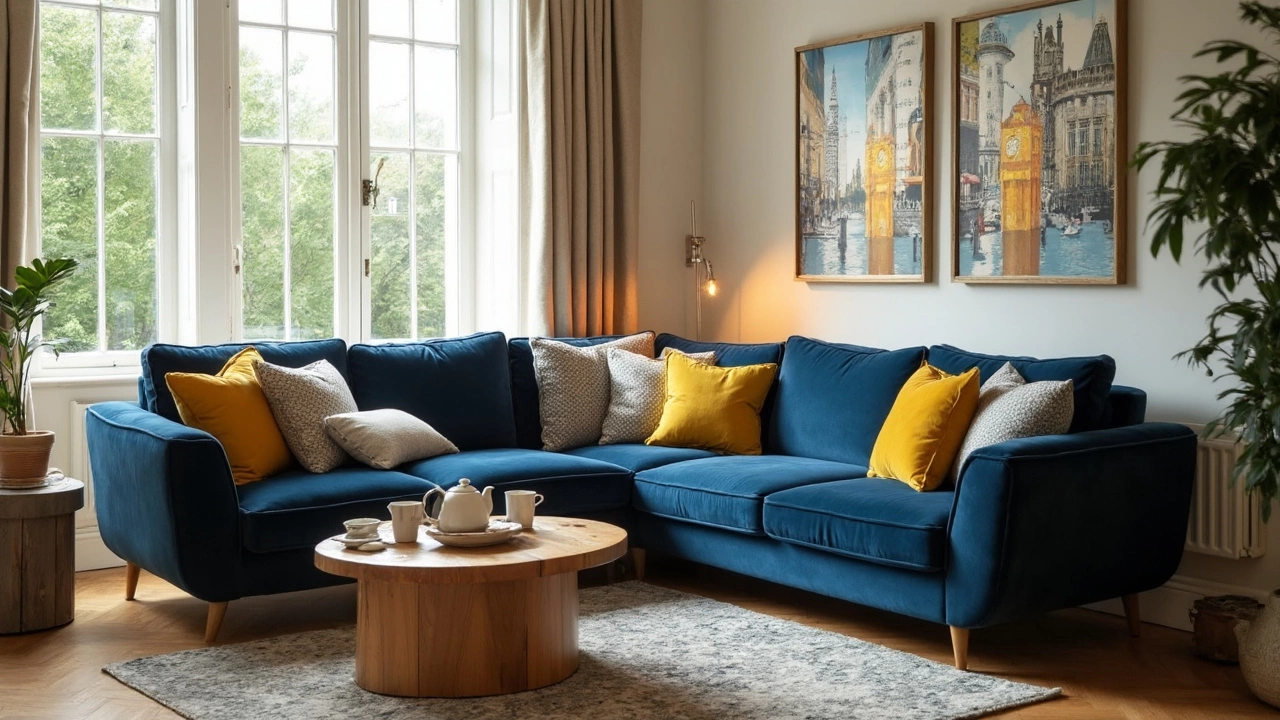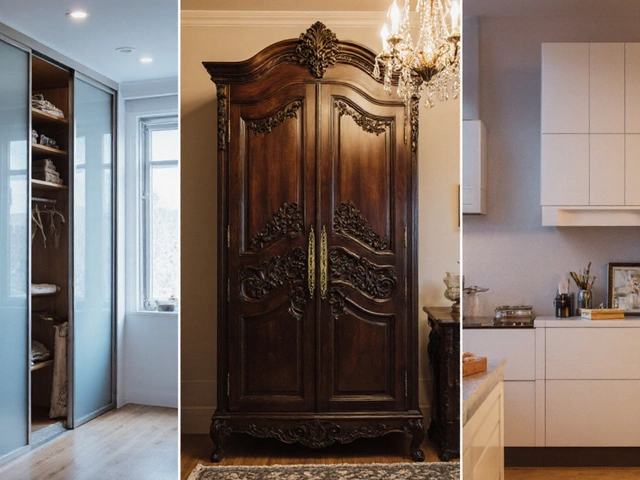 23
Apr,2025
23
Apr,2025
Ever hear people call it a corner couch, but then salespeople throw out words like "sectional" or "L-shaped sofa"? It gets confusing fast. Let’s clear things up. When you see that couch that fits snug into the corner of a room, it actually goes by a few different names depending on the shape and style. Most folks call it a "corner sofa" or "corner couch." But honestly, if it looks like an "L," it’s called an L-shaped sofa, and if it has an extra piece creating a "U," it’s a U-shaped sofa. The big umbrella term is "sectional sofa," which just means a sofa made up of separate sections that you can often rearrange or customize.
So if you’re furniture shopping and feel lost when somebody mentions "sectionals," just know they’re probably talking about the big sofas that bend around your living room. The best part? They’re built for lounging—and for making the most of awkward spaces. People love them because you can fit a bunch of friends or just stretch out and hog the whole thing. If you move a lot or like switching things up, sectionals can sometimes be split up or rearranged, which isn’t always possible with a regular couch.
- Corner Couch: The Real Names Explained
- Why Are Corner Sofas So Popular?
- Types of Corner Sofas: L-Shaped, U-Shaped, and More
- Key Features to Consider Before You Buy
- Space-Saving Tips and Arrangement Ideas
- Common Mistakes and How to Avoid Them
Corner Couch: The Real Names Explained
Let’s cut through the jargon you keep hearing at furniture stores. That big comfy spot in the corner of your living room? The most common name is a corner couch. If you want to get technical, people also call it a corner sofa—they mean the same thing. But walk into a store or search online, and you’ll see more labels like L-shaped sofa, U-shaped sofa, and the catch-all sectional sofa.
Here’s what those terms really mean:
- Corner Couch/Corner Sofa: Any couch built to slot right into a corner. It usually has two parts that meet at a right angle.
- L-shaped Sofa: This is the classic version you spot in most homes. It’s called L-shaped because, from above, it looks like the letter “L.” It fits two walls and gives you a natural corner to stretch out.
- U-shaped Sofa: Add one more section and you get a U shape, perfect for folks who host a crowd or want the ultimate lounging spot.
- Sectional Sofa: This term covers all sofas made up of separate pieces (sections) you can rearrange. Both L and U-shaped sofas are types of sectionals.
Don’t get tripped up by brands inventing new names. Sometimes you’ll see things like "modular sofa" or "reversible sectional." Modular just means you can move the pieces around. Reversible usually means you can switch which side the longer part (chaise) is on.
For a quick look at the main names, check this simple chart:
| Name | What It Means |
|---|---|
| Corner Couch/Sofa | Fits into the corner—two main sections |
| L-shaped Sofa | Looks like an "L"—two connected pieces |
| U-shaped Sofa | "U" shape, more seating and a bigger footprint |
| Sectional Sofa | Any multi-piece sofa, often customizable |
If you’re trying to search online, using "corner sofa" or "sectional sofa" as keywords usually brings up the best results. Knowing these names makes shopping a lot easier and stops you from getting upsold for no reason.
Why Are Corner Sofas So Popular?
Corner sofas—or as some call them, corner couches—aren’t just a style trend. There’s real practicality behind their rise. First off, they make the most out of awkward or small living rooms. That dead space in the corner? Suddenly, it’s the best seat in the house. People especially love them for open-plan homes because you can use a corner sofa to kind of separate the living area without any actual walls.
Sizing is another big advantage. A standard three-seater can only sit three people—maybe four if you really squeeze. But a basic L-shaped sofa lets a family of five sprawl out, and some sectional sofas can even seat seven or more. That’s why you see them in family rooms all over the place.
And let’s talk comfort. Stretching your legs out on that built-in chaise section? Nothing beats it after a long week. Plus, for anyone who likes movie nights or having friends over, these sofas are made for chilling together—not perching in a stiff row like you’re waiting at the dentist.
Here’s a quick comparison that shows how much seating you really get, side by side:
| Sofa Type | Average Seats | Main Benefit |
|---|---|---|
| Traditional Sofa | 3 | Simple, compact |
| L-Shaped Corner Sofa | 5-6 | Uses corner space, extra legroom |
| U-Shaped Corner Sofa | 6-8 | Fits big groups, feels social |
Another reason for their popularity is flexibility. Most sectional sofas now come in modular designs. Need to shuffle things around for a party or fit the sofa through a tight doorway? Just take it apart and reassemble it. If you often move, this is a lifesaver. And if your living space changes—maybe you buy a coffee table or put in a play area—just rearrange a section and you’re good to go.
In short, these sofas are everywhere because they’re practical, super comfortable, and help you squeeze every inch of value out of your living room—big or small.
Types of Corner Sofas: L-Shaped, U-Shaped, and More
If you walk into a furniture store or scroll through an online catalog, you’ll notice there’s more than one kind of corner couch. The main types are pretty easy to tell apart just by looking.
The classic L-shaped sofa is probably the most popular. It’s shaped exactly like an “L,” so it fits snug against two walls or lines the edge of an open plan room. This setup is perfect if you want to separate your living space from, say, your dining area, or just make a cozy spot for watching TV. Most L-shaped options seat four to six people, though you’ll find some more compact versions for smaller rooms.
Then there’s the U-shaped sofa. Imagine a giant “U”—it wraps around three sides. This one’s built for socializing, with everyone able to face each other. If you host a lot or have a big family, a U-shaped sectional gives you that togetherness vibe. They usually take up more space, but there’s no arguing they’re great for game nights or marathon movie sessions.
If you want something flexible, look for a modular sectional sofa. These let you rearrange the individual pieces into whatever shape you need—a longer line, an L, or a split-up seating area. Some modulars come with built-in storage or even pull-out beds. Talk about multitasking furniture!
Besides these, you’ll see things like “curved corner sofas,” which ditch sharp angles for a smooth, rounded look. Curved versions work in bigger rooms and are awesome for an open, airy layout. There’s also the chaise sectional, which is basically an L-shaped option where one side sticks out as a built-in lounger—ideal for putting your feet up after a long day.
To help keep things straight, check out this quick comparison of the most common corner sofa styles:
| Type | Main Shape | Perfect For | Seats |
|---|---|---|---|
| L-Shaped | L | Most living rooms, small to medium spaces | 4-6 |
| U-Shaped | U | Large rooms, families, social gatherings | 6-8 |
| Modular Sectional | Customizable | Flexibility, rearranging layouts | Varies |
| Curved | Curved arc | Large, open rooms, unique style | 5-7 |
Different types serve different needs. The trick is to think about how you live. Are you hosting friends, or do you just want to stretch out by yourself? Using the right shape can totally change how your living room feels and functions.

Key Features to Consider Before You Buy
Picking the right corner couch comes down to the details. You don’t want to spend money and realize later it’s too bulky, too uncomfortable, or just doesn’t fit your space. Here’s what to zero in on before you break out the credit card.
- Size and Fit: Measure your living room first. Grab a tape measure and check your floor space before you look at any L-shaped or sectional sofa. Don’t just eyeball it! The number one reason people return couches is because they didn’t fit through the door or took up half the room.
- Configuration: Some L-shaped sofas can be flipped (left- or right-facing). Others are fixed. Check if you can swap the sides to fit your space, especially if you move a lot or like to rearrange.
- Material: Think about how you’ll use it. Got pets? Go for tough, easy-to-clean fabrics. Leather looks fancy and is easy to wipe, but it can scratch. Plush fabrics like velvet feel awesome but collect lint and pet hair.
- Seating Depth and Comfort: Test it if you can. Deeper seats are best for lounging, while shallow ones are better for upright sitting. Most standard sofas have a seat depth of 21 to 24 inches. If you love binge-watching or napping, go deeper.
- Frame and Construction: Solid wood frames last longer. If you can, ask about the warranty. Avoid soft woods if you want it to last more than a couple years.
- Storage and Extras: Some corner sofas have built-in storage under the seats or even pull-out beds. It’s a lifesaver for small spaces or overnight guests.
Here’s a handy table showing the common materials used in corner sofas and what they’re best for:
| Material | Best For | Downsides |
|---|---|---|
| Leather | Easy cleaning, modern look | Scratches, can feel cold |
| Microfiber | Families, pets, stain resistance | May look less high-end |
| Velvet | Luxury vibe, comfort | Collects dust, needs care |
| Cotton/Poly Blend | Easy care, breathability | May fade over time |
Don’t just take my word for it. Interior designer Emily Henderson says,
“Sectionals are the MVP of living rooms because they maximize seating without crowding the area. But you have to nail the size and shape first.”
One thing people forget—the color. Neutral shades go with almost anything and are easier to dress up with bright pillows or throws. Bold colors show dirt less, but maybe not everyone in the family will love them down the road. You want something that fits your style but isn’t going to feel dated in a year.
Finally, wheels or adjustable legs can make cleaning and rearranging so much easier. It’s a small feature, but if you’ve ever jammed a vacuum under a heavy couch, you know it matters.
Space-Saving Tips and Arrangement Ideas
Trying to fit a corner couch or L-shaped sofa into a small living room can feel like a game of Tetris. But with a few smart tricks, you can save space and make your place look bigger, not cluttered.
First, push the corner sofa tight into a corner. This move instantly frees up floor space and helps open up the room. If your living room doubles as a walkway, keep the longer side of the couch along the wall with less foot traffic. Those with large open plans can use the sofa as a divider—think of it as a wall that doesn’t block light or make things feel closed off.
If your sectional sofa comes in movable pieces, get creative. Rearranging the sections means you can freshen up your space whenever you feel like it. Switching the chaise from left to right can even make the room feel like it got a remodel. Lots of people don’t realize that some L-shaped sofas let you swap which side the "L" sits on. Not sure which option you need? Double-check the couch’s specs before you click “buy.”
Don’t waste the space behind or beside your couch. Tuck in a slim console table behind the backrest for extra storage—a spot for keys, lamps, or even snacks. If your couch forms a natural nook, add a floor lamp for cozy lighting. In homes that need more storage, look for a corner couch that opens up for stashing blankets, games, or pillows underneath.
- Pick a light-colored corner couch to make a small room feel airier.
- Choose legs instead of a skirted base on your sofa to create the "floating furniture" effect—instant visual space.
- Stick with a low-profile sofa if your ceilings are low, to help the room feel less cramped.
- If your family eats at the couch a lot, add a couple of nesting side tables—they slide away when not in use.
- Avoid putting bulky furniture right across from the sectional; this blocks the open feel.
| Sofa Type | Average Floor Space Needed (sq ft) | Seating Capacity |
|---|---|---|
| Standard Three-Seater | 28 | 3 |
| L-Shaped Sectional | 32 | 5 |
| U-Shaped Sectional | 48 | 7+ |
*Based on typical living room layouts (2023 data from furniture retailers)
One last thing: always measure twice before buying a corner sofa. Many buyers forget about doorways, and end up with a couch stuck in the hallway. If your space is tricky, brands now make modular options that you build in the room—no tight corners, no drama.
Common Mistakes and How to Avoid Them
Shopping for a corner couch or sectional sofa can be tricky, and lots of folks trip up by not planning ahead. The number one headache? Not measuring the space right. You can’t just eyeball it—you really have to break out the tape measure and check both the length of each wall and the walking space around the sofa. Sofas that look perfect online can turn out to be way too bulky or too small when they show up. Honestly, this is where most returns happen.
Here’s a wild stat: According to a 2023 survey from Furniture Today, almost 30% of people who bought a sectional wished they’d measured more carefully for legroom and walkway space. That’s a lot of close calls for stubbed toes and cramped living rooms!
- Ignoring the doorways: Sometimes the couch fits your living room, but can’t even get through your front door or up the stairs. Double-check those entry spots too.
- Forgetting about the chaise side: L-shaped and U-shaped sofas often have a longer end (the chaise). Mixing up left-hand and right-hand layouts is super common, especially if you’re flipping the room design in your head. Look at your living room and imagine which side the long part will actually go.
- Picking style over comfort: That sharp modern sectional might look cool, but if the seats are too shallow or the back is too stiff, you won’t really use it. Always test the comfort at a store if you can, or double-check the seat depth and cushion fill in the description online.
- Choosing the wrong material: If you have pets or kids, some fabrics—like velvet or certain light colors—won’t last long. Microfiber and leather look good and are easier to clean. Don’t just go by the photos; read the care instructions!
- Assuming all sectionals are modular: Not every sectional sofa comes apart. Some are fixed in their L or U shape and that’s it. If you want flexibility, look for the word "modular" and check how the sections connect.
A solid bit of advice comes from Michelle Weiss, editor at HomeStyle Magazine:
"Measure twice, imagine the layout with painter’s tape on the floor, and pick fabrics that fit your real life—not just your dream board."If you skip these steps, you might end up stuck with a couch that’s more hassle than hangout.
| Reason | Percentage |
|---|---|
| Did not fit in the intended space | 42% |
| Wrong chaise orientation | 19% |
| Uncomfortable seating | 15% |
| Material not practical | 13% |
| Could not deliver through entry | 11% |
Next time you shop for a corner sofa, save money and nerves by mapping your space, going with the right practical fabric, and not just getting hooked by looks. It’s all about making sure your perfect chill spot actually fits real life.




